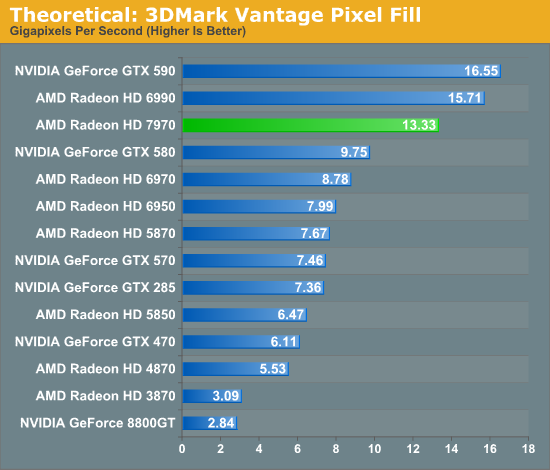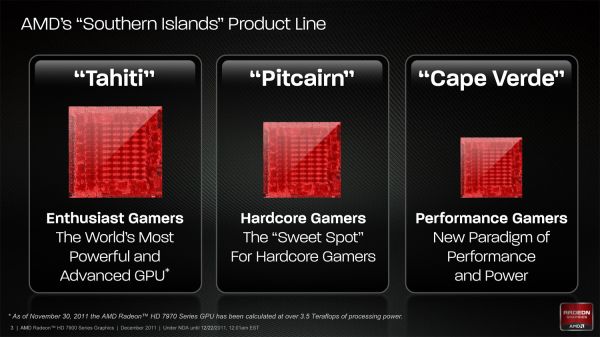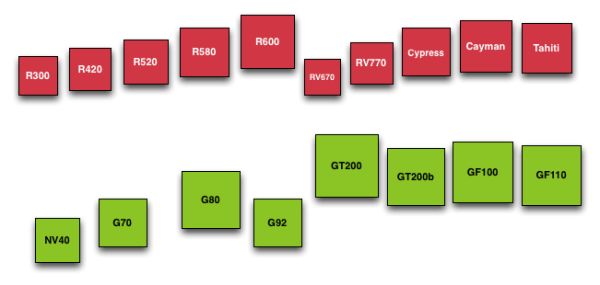AMD Radeon HD 7970 Review: 28nm And Graphics Core Next, Together As One
by Ryan Smith on December 22, 2011 12:00 AM EST- Posted in
- GPUs
- AMD
- Radeon
- ATI
- Radeon HD 7000
Building Tahiti & The Southern Islands
Now that we’ve had a chance to go over the basis of the Graphics Core Next architecture, let’s talk about the finished products.
Today AMD will be launching Tahiti, the first GPU of the Southern Islands family. Southern Islands will initially be composed of 3 GPUs: Tahiti, Pitcairn, and Cape Verde. Tahiti is the largest and most powerful member of the Southern Islands family, while Pitcairn and Cape Verde get progressively smaller. AMD has not yet announced the branding or launch dates for Pitcarn and Cape Verde, but it typically takes AMD around 6 months to launch a complete family. As such it’s reasonable to expect that all 3 GPUs will have launched by the end of June although there’s a good likelihood of it happening sooner than that.
All 3 GPUs are based on the GCN architecture, and as family members will have similar features while varying the number of functional units accordingly. Along with the architecture change Southern Islands brings with it a slew of additional features that we’ll get to in the following pages, including Partially Resident Texture (PRT) support, PCIe 3.0, FastHDMI, Direct3D 11.1, and AMD’s fixed-function H.264 encoder, the Video Codec Engine.
But today is all about Tahiti, so let’s get down to business.
As we quickly covered in our introduction, Tahiti is a 4.31B transistor GPU based on the GCN architecture and built on TSMC’s new 28nm High-K process. Due to TSMC canceling their 32nm process last year AMD has had to wait over 2 years for the next full node rather than taking advantage of the half-node process as they typically do, and as a result the jump from Cayman at 40nm to Tahiti at 28nm is much bigger than with past product launches. Whereas Cayman had 2.64B transistors and a die size of 389mm2, Tahiti has a whopping 63% more transistors than Cayman and yet it’s still smaller, coming in at a slightly more petite 365mm2.
At this point AMD hasn’t provided us with the typical board power values for 7970, but we do know that PowerTune is limited to 250W. In terms of design 7970 is clearly intended to work in similar environments as the 6970, in which case power consumption should be similar to the 6970.
Interestingly enough however we’re hearing that 7970 cards are proving to be very overclockable, which is a good sign for the state of TSMC’s 28nm process, and at the same time a bit distressing. Moore’s Law has continued to hold with respect to transistor density, but the power consumption benefits of using smaller nodes has continued to wane. Having a lot of overclocking headroom means that the 7970 has the potential to be much faster, but it also means that the 7970 (and 28nm GPUs in general) are going to be bottlenecked by power. In which case seeing as how we’re already approaching 300W with single-GPU video cards, the performance gains realized from future fabrication processes would be limited to the ever diminishing returns on power consumption improvements.
Diving deeper into Tahiti, as per the GCN architecture Tahiti’s 2048 SPs are organized into 32 Compute Units. Each of these CUs contains 4 texture units and 4 SIMD units, along with a scalar unit and the appropriate cache and registers. At the 7970’s core clock of 925MHz this puts Tahiti’s theoretical FP32 compute performance at 3.79TFLOPs, while its FP64 performance is ¼ that at 947GFLOPs. As GCN’s FP64 performance can be configured for 1/16, ¼, or ½ its FP32 performance it’s not clear at this time whether the 7970’s ¼ rate was a hardware design decision for Tahiti or a software cap that’s specific to the 7970. However as it’s obvious that Tahiti is destined to end up in a FireStream card we will no doubt find out soon enough.
Meanwhile the frontend/command processor for Tahiti is composed of 2 Asynchronous Command Engines (ACEs) and 2 geometry engines. Just as with Cayman each geometry engine can dispatch 1 triangle per clock, giving Tahiti the same theoretical 2 triangle/clock rate as Cayman. As we’ll see however, in practice Tahiti will be much faster than Cayman here due to efficiency improvements.
Looking beyond the frontend and shader cores, we’ve seen a very interesting reorganization of the rest of the GPU as opposed to Cayman. Keeping in mind that AMD’s diagrams are logical diagrams rather than physical diagrams, the fact that the ROPs on Tahiti are not located near the L2 cache and memory controllers in the diagram is not an error. The ROPs have in fact been partially decoupled from the L2 cache and memory controllers, which is also why there are 8 ROP partitions but only 6 memory controllers. Traditionally the ROPs, L2 cache, and memory controllers have all been tightly integrated as ROP operations are extremely bandwidth intensive, making this a very unusual design for AMD to use.
As it turns out, there’s a very good reason that AMD went this route. ROP operations are extremely bandwidth intensive, so much so that even when pairing up ROPs with memory controllers, the ROPs are often still starved of memory bandwidth. With Cayman AMD was not able to reach their peak theoretical ROP throughput even in synthetic tests, never mind in real-world usage. With Tahiti AMD would need to improve their ROP throughput one way or another to keep pace with future games, but because of the low efficiency of their existing ROPs they didn’t need to add any more ROP hardware, they merely needed to improve the efficiency of what they already had.
The solution to that was rather counter-intuitive: decouple the ROPs from the memory controllers. By servicing the ROPs through a crossbar AMD can hold the number of ROPs constant at 32 while increasing the width of the memory bus by 50%. The end result is that the same number of ROPs perform better by having access to the additional bandwidth they need.

The big question right now, and one we don’t have an answer to, is what were the tradeoffs for decoupling the ROPs? Clearly the crossbar design has improved ROP performance through the amount of memory bandwidth they can access, but did it impact anything else? The most obvious tradeoff here would be for potentially higher latency, but there may be other aspects that we haven’t realized yet.
On that note, let’s discuss the memory controllers quickly. Tahiti’s memory controllers aren’t significantly different from Cayman’s but there are more of them, 50% more in fact, forming a 384bit memory bus. AMD has long shied away from non-power of 2 memory busses, and indeed the last time they even had a memory bus bigger than 256bits was with the ill-fated 2900XT, but at this point in time AMD has already nearly reached the practical limits of GDDR5. AMD’s ROPs needed more memory bandwidth, but even more than that AMD needed more memory bandwidth to ensure Tahiti had competitive compute performance, and as such they had little choice but to widen their memory bus to 384bits wide by adding another 2 memory controllers.
It’s worth noting though that the addition of 2 more memory controllers also improves AMD’s cache situation. With 128KB of L2 cache being tied to each memory controller, the additional controllers gave AMD 768KB of L2 cache, rather than the 512KB that a 256bit memory bus would be paired with.














292 Comments
View All Comments
nitro912gr - Thursday, December 22, 2011 - link
I was planning a switch from AMD (4850) to a(n) nVidia GPU for my next upgrade, because they perform well both in computing and in gaming, and I need both fields to be filled here.But now I'm not sure about that, I will wait a bit to see how the software will welcome the new architecture first.
I hope they work as well so I can just pick the cheapest GPU.
Chloiber - Thursday, December 22, 2011 - link
The thing I still don't like about the new AMD cards is their massive problems with anisotropic filtering. AMD promised twice (with Cayman and Tahiti) that the "AF-Bug" is gone. But it's still mediocre to NV and worse than older cards (pre-R600).The bad thing about this is, that it's easily detectable in games and not just a theoretical flaw. It got better than Cayman, but it's still worse than NVs AF.
CeriseCogburn - Thursday, March 8, 2012 - link
Yes, thank you for that. We are supposed to ignore all amd radeon issues and failures and less thans, though, so we can extoll the greatness....Then when they "finally catch up to nvidia years later with some fix", the reviewers can tell us and admit openly that amd radeon has a years long problem of inferiority to nvidia that they "finally solved" and then we can get a gigantic zipped up download to show what "was for years amd fail hidden and not spoken of" is gone !
Hurrah !
Wow it's so much fun seeing it happen, again.
KoVaR - Thursday, December 22, 2011 - link
Awesome job on power consumption and noise levels. If only AMD did so well in the CPU realm...alpha754293 - Thursday, December 22, 2011 - link
Can you play a game while running a compute job?There's word that even for the nVidia Tesla compute accelerators (based on Fermi) that it stutters when you try to play a game or video while it is actively computing/working on something else.
Is that the case here too?
SlyNine - Thursday, December 22, 2011 - link
I'm sure it does, Context switching still occures a huge penalty.MrSpadge - Thursday, December 22, 2011 - link
GCN won't be able to help this on its own. The software needs to catch up. It's a major concern for true GP-GPU and heterogenous computing, though! And not even just launching a game, trying to use your desktop is enough of a problem already..MrS
shin0bi272 - Thursday, December 22, 2011 - link
Id really like to see is when you guys bench with an nvidia physx game... run the bench with physx on (maxed out if there's an option) once and off once.I know everyone is going to claim that physx is a gimmick but a good portion of that reason is because when a game supports it NO ONE BENCHMARKS IT WITH IT ON! That's like buying a big screen tv and covering half of it with duct tape. And lets not forget AMD opted to not use the tech when nvidia offered it to them... so AMD's loss is Nvidia's gain and no one uses it in their reviews because its not hardware neutral. That's partial favoritism IMHO.
Also why wasnt the gtx590 or the 6990 tested @ 16x10 dx10 HQ 16xaf on Metro2033? The 580 was tested and the 6970 were but not the dual chip cards. Whats up with that?
Finally - Thursday, December 22, 2011 - link
Spoken like a true Nvidia viral marketing shillshin0bi272 - Friday, December 23, 2011 - link
So because I prefer the extra eye candy physx offers I cant ask a question about a testing methodology? Sounds like someone has physx envy.